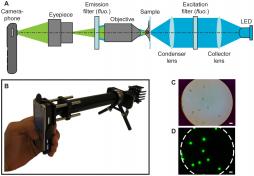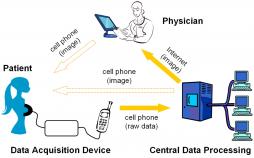medical imaging
Posted by SushmitaNY on Aug 20, 2009
Newsweek recently did a story on this discovery entitled Dial "D" for Diagnosis. The story makes the connection to what we reported on ealier: the potential of mobile tech for disease diagnosis.
This potentially socially transforming technology was the result of a challenge to a class of Biomedical Engineering graduate students at University of California, Berkeley, by Professor Daniel Fletcher.
He asked the students to respond to an imaginary scenario: You are hiking in a remote village where an unknown infectious disease is spreading. What could you build with only a camera cell phone and a backpack of lenses that might help identify the disease? The product: the Cellscope (please bear with the intro advert) and here is the YouTube video.
Posted by SushmitaNY on Aug 16, 2009
A group of researchers from University of California at Berkeley and San Francisco have built a fascinating new device, which should make disease diagnosis in the field in the developing world a lot more feasible. The new device takes advantage of the recent penetration of mobile telephones in the remotest parts of the world – places where there are few health amenities, or even reliable roads and power.
Most mobile telephones today have built-in cameras which, although they may not be the dream of a professional photographer, can nevertheless produce digital images at sufficient resolution for diagnostic pathology. The researchers have combined a camera-equipped mobile phone with a simple light microscope, and packaged it into a simple, portable and rugged “diagnostic field microscope” (for technical details, please see here).
Posted by SushmitaNY on Aug 16, 2009
Medical imaging has revolutionized western medicine in the past two decades, with the frontiers being constantly pushed to allow better, earlier and faster diagnosis for a variety of diseases. The story is quite different, however, in the developing world where, according to recent WHO estimates, over 50% of medical equipment that is available is not being used because it is too sophisticated or in disrepair or because the health personnel are not trained to use it. WHO further estimates that some three quarters of the world population does not have access to medical imaging.
One problem that may be at least partially responsible for this discrepancy is that typical medical imaging equipment is large, non-portable, expensive, require multiple components to work in concert (data acquisition, data analysis, image rendering and visual display), and require highly trained personnel to operate them optimally.



